Workout – Build Muscle

Technically speaking, acquiring muscle mass requires stressing your body to the point of triggering an acute inflammatory response that generates protein synthesis. Practically speaking, that’s what the superset does: pairing movements that target a specific area of the body and repeating them.
But technically speaking, the process of acquiring muscle mass also leaves you prone to injury, thanks to repetitive stress and extreme inflammation. “Dividing” your body into zones and overloading each zone—for leg day, or back day, and so on—is contrary to our physiology, which is designed to spread the load in order to minimize the chance of injury. Overload that’s isolated to specific parts of the body can lead to tendonitis and impingement syndromes that restrict your range of motion, so while the exterior looks great, the interior is beat up.
This workout incorporates joint-strengthening, mobility and recovery exercise movements to harness your physiological responses to stress in a way that’s productive instead of harmful.
To make this workout work for you, consider two other potential disruptors that are built into conventional wisdom about muscle-gain protocols. Caloric intake is necessary to build mass, but eating a lot of inflammatory foods can have a negative effect. And insufficient recovery can amplify the risk of injury. You can downgrade your disruptors to get more from the workout by choosing what to put in your body and building sufficient recovery time into your routine.
Warm-Up
Workout
- Perform eight to 12 reps of each movement before moving on to the next in each pair.
- Perform each pair as a superset, three times, before moving on to the next superset pairing.
- Choose weight that’s heavy enough to create fatigue but not total exhaustion.

Superset 1A: Lateral Crawl Push-Up With Band Across Back
- Begin in an extended plank pose, with your feet hip-width apart, your toes on the ground and your hands under your shoulders.
- Hold a band in both hands, letting it sit across your upper back.
- Perform a push-up, then walk your hands and feet laterally for one step, and perform another push-up. Walk back to start and perform a push-up.
- Continue alternating between push-ups and lateral walks, keeping your spine long from head to heels and the band taut across your back.
- Modify it: If your disruptors are high, perform the push-up without the lateral crawl. You’ll reduce neural fatigue without sacrificing calorie burn.
Superset 1B: Air Squat
- Begin standing with your feet wider than your hips, hands at your sides.
- Sit your hips back and down, bending your knees and placing your body weight in your heels. Let your hands come forward to meet in front of your chest for balance.
- Stop your hips at knee height, then push through your heels to return to stand. Repeat at a quick, steady pace.
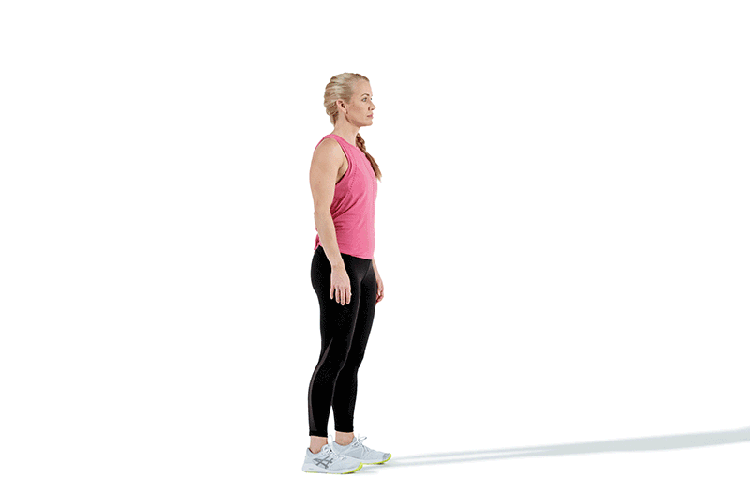
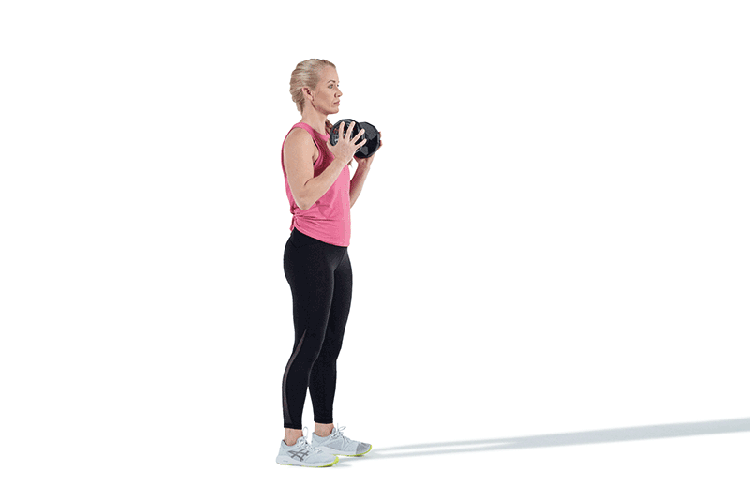
Superset 2A: Dumbbell Front Squat
- Begin standing with your feet wider than your hips, hands holding a dumbbell in front of your chest.
- Sit your hips back and down, bending your knees and placing your weight in your heels.
- Stop your hips at knee height, then push through your heels to return to stand. Repeat.
Superset 2B: Forward Jump Squat With Step-Back
- Begin standing with your feet under your hips, hands at your sides.
- Bend to squat down, bringing your hands behind your back, then jump forward. Land softly with your knees bent.
- Take a step back to the starting point and repeat. Alternate between jumping forward and stepping back.
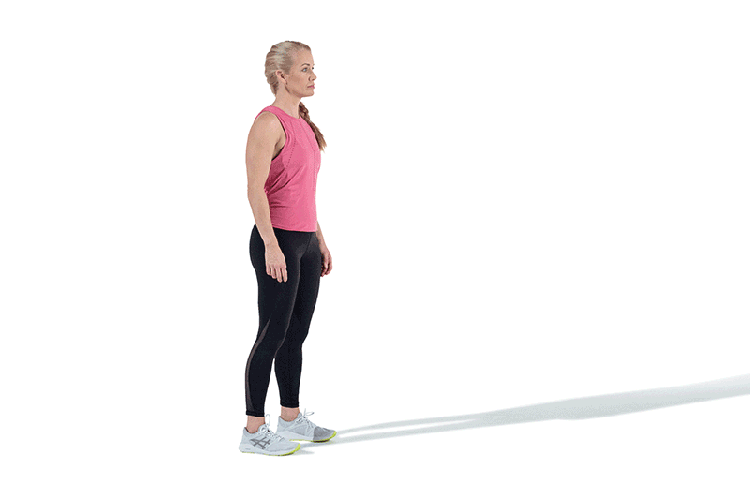

Superset 3A: Lateral Lunge With Dumbbell Biceps Curl
- Begin standing with your feet under your hips, holding dumbbells at your sides.
- Step your right foot out laterally and sink back into a lunge, bending your left knee and sitting back on your left hip. At the bottom of the lunge, perform a biceps curl.
- Return the dumbbells down and press through your left heel to return to stand. Repeat on the opposite leg, alternating legs.
Superset 3B: Skipping in Place
- Begin standing with your feet under your hips, hands at your sides.
- Drive your right knee up toward hip height, pumping your arms and keeping your spine long and your chest lifted.
- Return your right foot toward the ground and hop your left knee up toward hip height.
- Continue skipping in place, alternating legs.

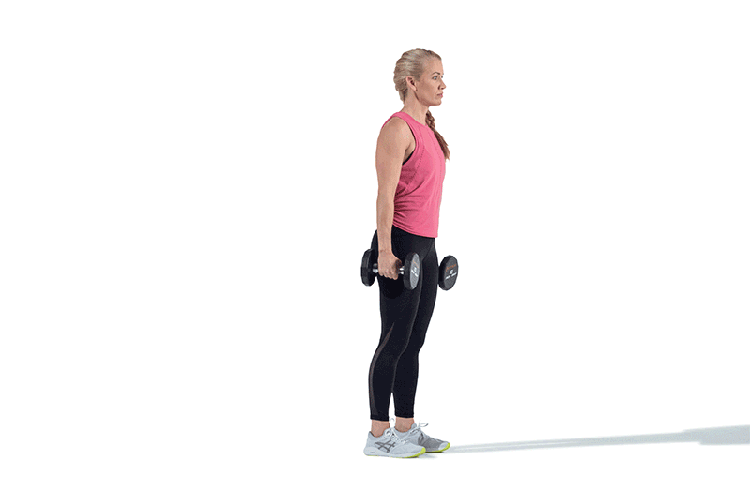
Superset 4A: Dumbbell Triceps Kickback
- Begin standing with your feet under your hips, holding dumbbells at your sides.
- Step your right foot back and lean forward over your left leg, bending your left knee and placing your gaze about 3 feet in front of your body.
- Bring your elbows up toward the ceiling, then straighten your arms to kick the dumbbells straight back.
- Bend your elbows to bring the dumbbells to your shoulders and repeat, kicking them back and bringing them forward, squeezing your elbows in and keeping them high.
Superset 4B: Lateral and Return Squat Jump
- Begin standing with your feet under your hips, hands at your sides.
- Bend your knees to squat down, bringing your hands behind you.
- Swing them forward and jump laterally and land in a squat. Quickly spring back and land in a squat.
- Repeat, squat jumping laterally back and forth, using your arms for momentum.

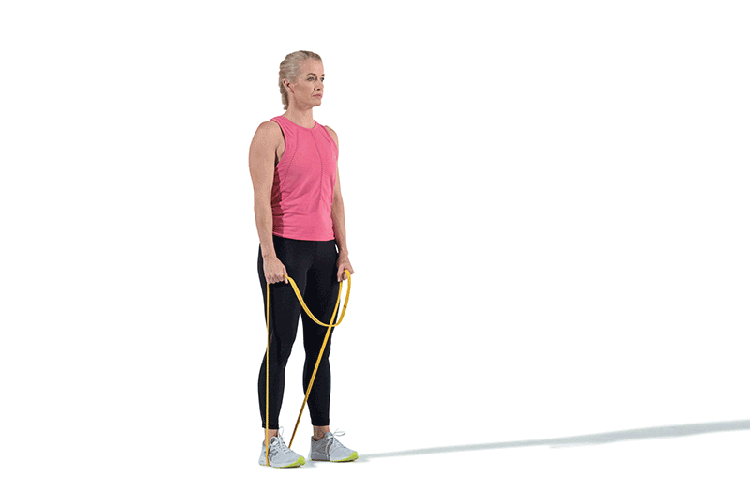
Superset 5A: Lateral Lunge With Band Row
- Begin standing with your feet under your hips, a band under your right foot and holding the band in both hands.
- Lunge your left leg out and sit back on your left hip, then pull your hands up toward your ribs, sending your elbows straight up and squeezing your shoulder blades together.
- Row the band back down, and press through your left heel to return to stand. Repeat, then switch legs.
Superset 5B: Jumping Jack
- Begin standing with your feet under your hips, arms by your sides.
- Bring your arms out and up above your head and jump your feet out wide.
- Drop your arms back down and bring your feet together. Repeat.

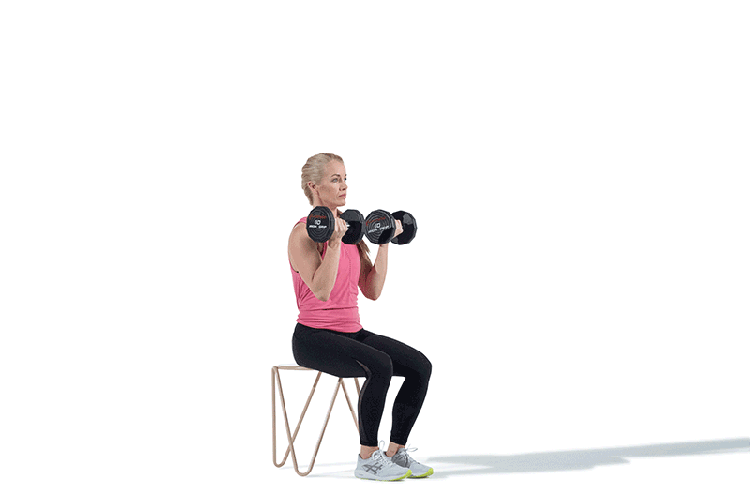
Superset 6A: Seated Arnold Press
- Begin seated with your feet flat on the ground and holding dumbbells in a curl in front of your shoulders.
- Press the dumbbells up above your head and straighten your arms and externally rotate your wrists.
- Stop at the top, then internally rotate the dumbbells as you lower them back in front of your shoulders. Repeat, keeping your spine tall and bracing your core to keep from swaying.
Superset 6B: Lateral Skip
- Begin standing with your feet under your hips, arms at your sides.
- Drive your right knee up as you skip up and to the right on your standing leg. Place your right foot down while skipping up and drive your left knee up and skip to the left.
- Repeat, skipping back and forth and side to side, driving your knees up to hip height and swinging your arms.
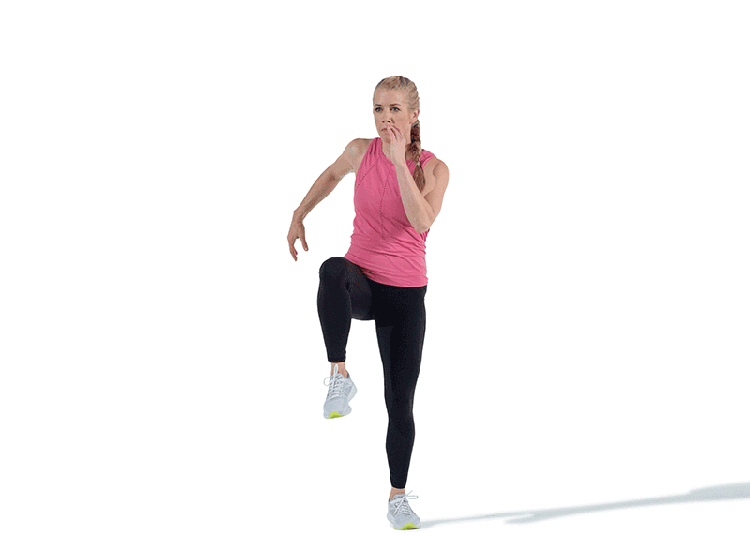
Cool-Down
Photo credit: astarot, iStock
GIFs: Mark Kuroda, kurodastudios.com
Model Credit: Andrea Bidwell, 24 Hour Fitness